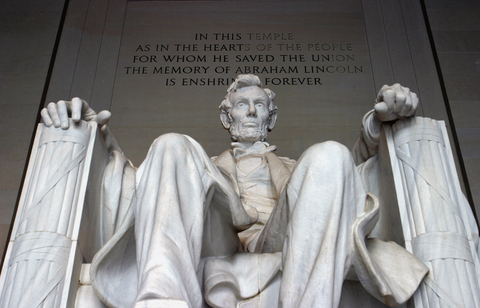Remembering Lincoln: 150 Years Later

Seven score and 10 years ago the United States ended a brutal conflict and lost their charismatic president. Museums and traveling exhibits are using the 150th anniversary of the end of the Civil War and President Abraham Lincoln’s assassination to reflect on perhaps the darkest period in American history.
Some memorials, like Civil War battlegrounds and the spot of Lincoln’s assassination, operate throughout the year and have drawn millions of visitors over the years. One exhibit commemorates the sesquicentennial anniversary of Lincoln’s assassination by recreating the route of his funeral train.
The refurbished train is a replica of the one which carried Lincoln’s body from Washington D.C. to Springfield, Ill. and includes finishes from the original. The president’s procession traversed 1,600 miles through about 160 communities. A dozen major cities honored Lincoln with funerals during the 12-day trip. An untold number of mourners flanked the railways to honor their fallen as the engine rumbled past.
To this day, tourists flock to Gettysburg, Penn., a turning point in the war and Virginia’s Appomattox courthouse, where the Confederacy forfeit to officially end the conflict.
Ford’s Theatre in Washington D.C., the site of Lincoln’s assassination, hosts walking tours showcase the theater, as well as the nearby home the wounded president was transported to for emergency care.
The still-operating theater doubles as a museum for Lincoln-related artifacts like the playbill of “Our American Cousin”, the show he attended with his wife that fateful evening. Also on display are the clothes Lincoln wore during the attack and items belonging to assassin John Wilkes Booth, a Confederate sympathizer and actor in the evening’s play.
About Abraham Lincoln
The celebrated orator was profound policy shaper. He’s widely considered to be one of the elite leaders in the nation’s history.
He’s the subject of scores of books, dozens of films and literally countless term papers. Because of his placement on the penny and $5 bill you likely don’t go a day without seeing his face. Cities, counties, streets and a line of luxury vehicles bear his name.
Largely self-educated and a voracious reader, Lincoln was raised in poverty. He split rails before studying law and opening a practice in his native Illinois. He served multiple terms in the House of Representatives and lost a bid for Senate before being elected president in 1860.
Lincoln’s credited with keeping the nation whole as the country trudged through a war that resulted in more American deaths than any armed conflict in history.
He championed the emancipation of slaves and lobbied for equality, knowing full well he would likely pay with his life. He did exactly that on April 15, 1865 in Ford’s Theatre in Washington D.C.
-Lincoln Funeral Train
When: Begins May 2
What it is: A recreation of the train Lincoln traveled in as president and what carried his body on a 12-day, 1,600-mile funeral procession.
Where: Springfield, Ill.
Website: www.The2015LincolnFuneralTrain.com/
-Silent Witnesses: Artifacts of the Lincoln Assassination
When: March 23 to May 25
What it is: A collection of materials related to the Lincoln assassination. Exhibits include the coat Lincoln wore, Booth’s Deringer pistol and a letter penned by the doctor whom first tended to wounded leader.
Where: Ford’s Theatre, 511 10th St. NW, Washington, D.C., 20004
Website: www.Fords.org/event/silent-witnesses